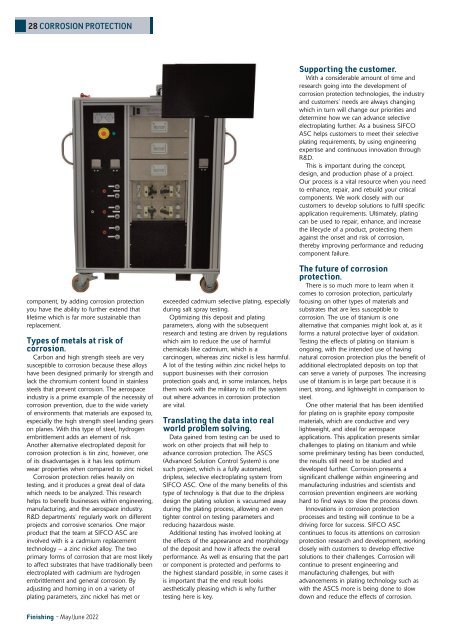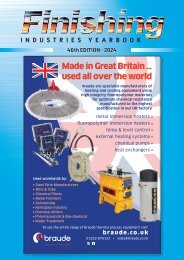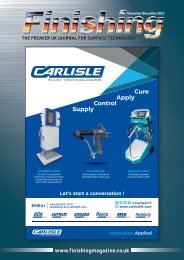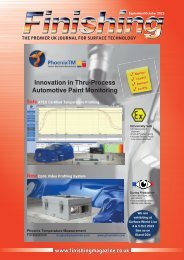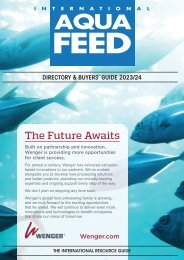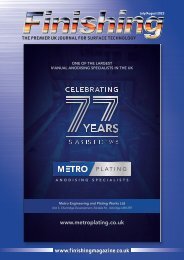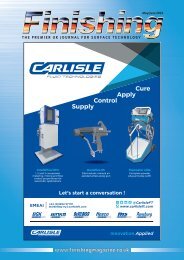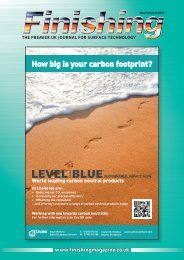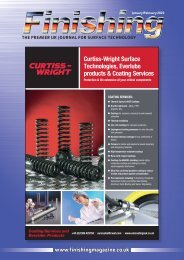You also want an ePaper? Increase the reach of your titles
YUMPU automatically turns print PDFs into web optimized ePapers that Google loves.
28 CORROSION PROTECTION<br />
component, by adding corrosion protection<br />
you have the ability to further extend that<br />
lifetime which is far more sustainable than<br />
replacement.<br />
Types of metals at risk of<br />
corrosion.<br />
Carbon and high strength steels are very<br />
susceptible to corrosion because these alloys<br />
have been designed primarily for strength and<br />
lack the chromium content found in stainless<br />
steels that prevent corrosion. The aerospace<br />
industry is a prime example of the necessity of<br />
corrosion prevention, due to the wide variety<br />
of environments that materials are exposed to,<br />
especially the high strength steel landing gears<br />
on planes. With this type of steel, hydrogen<br />
embrittlement adds an element of risk.<br />
Another alternative electroplated deposit for<br />
corrosion protection is tin zinc, however, one<br />
of its disadvantages is it has less optimum<br />
wear properties when compared to zinc nickel.<br />
Corrosion protection relies heavily on<br />
testing, and it produces a great deal of data<br />
which needs to be analyzed. This research<br />
helps to benefit businesses within engineering,<br />
manufacturing, and the aerospace industry.<br />
R&D departments’ regularly work on different<br />
projects and corrosive scenarios. One major<br />
product that the team at SIFCO ASC are<br />
involved with is a cadmium replacement<br />
technology – a zinc nickel alloy. The two<br />
primary forms of corrosion that are most likely<br />
to affect substrates that have traditionally been<br />
electroplated with cadmium are hydrogen<br />
embrittlement and general corrosion. By<br />
adjusting and homing in on a variety of<br />
plating parameters, zinc nickel has met or<br />
exceeded cadmium selective plating, especially<br />
during salt spray testing.<br />
Optimizing this deposit and plating<br />
parameters, along with the subsequent<br />
research and testing are driven by regulations<br />
which aim to reduce the use of harmful<br />
chemicals like cadmium, which is a<br />
carcinogen, whereas zinc nickel is less harmful.<br />
A lot of the testing within zinc nickel helps to<br />
support businesses with their corrosion<br />
protection goals and, in some instances, helps<br />
them work with the military to roll the system<br />
out where advances in corrosion protection<br />
are vital.<br />
Translating the data into real<br />
world problem solving.<br />
Data gained from testing can be used to<br />
work on other projects that will help to<br />
advance corrosion protection. The ASCS<br />
(Advanced Solution Control System) is one<br />
such project, which is a fully automated,<br />
dripless, selective electroplating system from<br />
SIFCO ASC. One of the many benefits of this<br />
type of technology is that due to the dripless<br />
design the plating solution is vacuumed away<br />
during the plating process, allowing an even<br />
tighter control on testing parameters and<br />
reducing hazardous waste.<br />
Additional testing has involved looking at<br />
the effects of the appearance and morphology<br />
of the deposit and how it affects the overall<br />
performance. As well as ensuring that the part<br />
or component is protected and performs to<br />
the highest standard possible, in some cases it<br />
is important that the end result looks<br />
aesthetically pleasing which is why further<br />
testing here is key.<br />
Supporting the customer.<br />
With a considerable amount of time and<br />
research going into the development of<br />
corrosion protection technologies, the industry<br />
and customers’ needs are always changing<br />
which in turn will change our priorities and<br />
determine how we can advance selective<br />
electroplating further. As a business SIFCO<br />
ASC helps customers to meet their selective<br />
plating requirements, by using engineering<br />
expertise and continuous innovation through<br />
R&D.<br />
This is important during the concept,<br />
design, and production phase of a project.<br />
Our process is a vital resource when you need<br />
to enhance, repair, and rebuild your critical<br />
components. We work closely with our<br />
customers to develop solutions to fulfil specific<br />
application requirements. Ultimately, plating<br />
can be used to repair, enhance, and increase<br />
the lifecycle of a product, protecting them<br />
against the onset and risk of corrosion,<br />
thereby improving performance and reducing<br />
component failure.<br />
The future of corrosion<br />
protection.<br />
There is so much more to learn when it<br />
comes to corrosion protection, particularly<br />
focusing on other types of materials and<br />
substrates that are less susceptible to<br />
corrosion. The use of titanium is one<br />
alternative that companies might look at, as it<br />
forms a natural protective layer of oxidation.<br />
Testing the effects of plating on titanium is<br />
ongoing, with the intended use of having<br />
natural corrosion protection plus the benefit of<br />
additional electroplated deposits on top that<br />
can serve a variety of purposes. The increasing<br />
use of titanium is in large part because it is<br />
inert, strong, and lightweight in comparison to<br />
steel.<br />
One other material that has been identified<br />
for plating on is graphite epoxy composite<br />
materials, which are conductive and very<br />
lightweight, and ideal for aerospace<br />
applications. This application presents similar<br />
challenges to plating on titanium and while<br />
some preliminary testing has been conducted,<br />
the results still need to be studied and<br />
developed further. Corrosion presents a<br />
significant challenge within engineering and<br />
manufacturing industries and scientists and<br />
corrosion prevention engineers are working<br />
hard to find ways to slow the process down.<br />
Innovations in corrosion protection<br />
processes and testing will continue to be a<br />
driving force for success. SIFCO ASC<br />
continues to focus its attentions on corrosion<br />
protection research and development, working<br />
closely with customers to develop effective<br />
solutions to their challenges. Corrosion will<br />
continue to present engineering and<br />
manufacturing challenges, but with<br />
advancements in plating technology such as<br />
with the ASCS more is being done to slow<br />
down and reduce the effects of corrosion.<br />
<strong>Finishing</strong> - <strong>May</strong>/<strong>June</strong> <strong>2022</strong>


